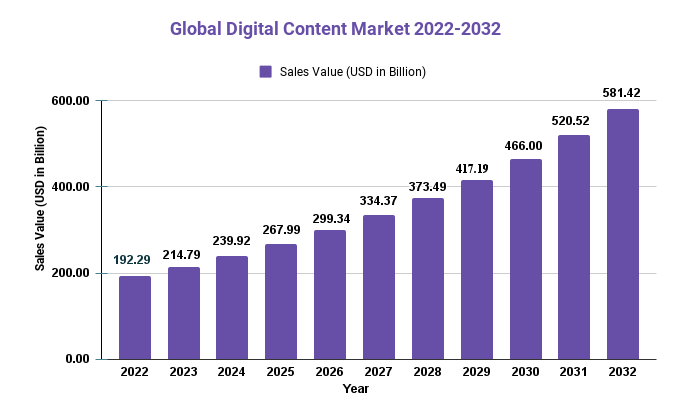Digital Content Market Size To Reach USD 581.42 billion By 2032

Page Contents
Published Via 11Press: The digital content market has seen remarkable growth over recent years and is expected to keep expanding at an impressive rate in the future. Digital content includes any type of creative work created, distributed and consumed digitally in any format – such as e-books, music, videos, online games and mobile applications.
Market.us research report states the global digital content market size was valued at USD 192.29 billion in 2022 and is projected to expand at a compound annual growth rate (CAGR) of 11.7% from 2022-2032.
The growing adoption of smartphones, tablets, and other mobile devices, along with the rise of social media and online streaming platforms, are some of the primary factors driving growth within this space.
Request For Sample Report Here | https://market.us/report/digital-content-market/request-sample
Key Takeaways:
- The global digital content market is rapidly growing. In 2020, it reached USD 154.12 Billion with CAGRs of 11.7% expected between 2021-2028.
- The digital content market is experiencing unprecedented growth due to the widespread adoption of smartphones, tablets and other mobile devices as well as an uptick in interest in online streaming services and social media platforms.
- Due to an increasing number of people staying at home and relying on digital entertainment and education options, the COVID-19 crisis has only further driven up demand for digital material.
- North America is expected to remain the leading market for digital contents, while Asia Pacific should experience the fastest growth over the forecast period.
- Companies from a wide range of sectors are now investing in digital content.
- Digital content encompasses a variety of formats, such as music, videos, games online and apps for mobile devices.
- The future growth of digital content industry is expected to be significant, due to technological advances and shifts in consumer behaviour.

Regional Snapshot
- North America: North America is expected to remain the leading market for digital content due to its high penetration of devices and infrastructure, as well as major providers like Netflix, Amazon Prime Video, and Google. The United States accounts for the lion's share of North American revenue in this space – contributing nearly one-fourth of total market revenue.
- Europe: Europe is the second-largest market for digital content, driven by rising demand for entertainment and educational options. The United Kingdom, Germany, and France are the major contributors to this European digital content market.
- Asia Pacific: The Asia Pacific region is expected to experience the highest growth rate over the forecast period due to its large and rapidly aging population, rising internet penetration rates, and rising disposable incomes. China, Japan, India, and South Korea are leading contributors to this region's digital content market.
- Latin America: The Latin American digital content market is expected to experience rapid growth during the forecast period due to an increasing adoption of digital devices and infrastructure. Brazil and Mexico are the major contributors to this market.
Drivers
- Adoption of digital devices: The rising popularity of smartphones, tablets and other electronic devices has resulted in an exponential growth in digital content consumption. People are using these devices to access various types of digital files like e-books, music, videos, online games and mobile applications.
- Rising internet penetration: The increasing availability and affordability of high-speed internet access is making digital content distribution and consumption much easier, especially in developing regions where internet penetration rates are growing rapidly.
- Consumer Behaviour Shift: Consumers are increasingly turning to digital channels for entertainment, education and other forms of content consumption. This trend is being driven by an increase in on-demand and personalized viewing habits as well as the rising popularity of online streaming platforms and social media networks.
- Technological Aheadlines: Technological advances such as artificial intelligence, cloud computing and 5G networks are revolutionizing the creation, distribution and consumption of digital content. These innovations give content providers an edge to deliver more engaging and personalized content to viewers.
Restraints
- Piracy and copyright infringement: Piracy and copyright infringement remain a major challenge for the digital content market, particularly in emerging nations with weak enforcement of intellectual property laws. This can result in revenue losses for content providers as well as hindering overall growth within this space.
- High competition and fragmentation: The digital content market is highly competitive and fragmented, with a large number of providers offering similar content. This can present challenges in customer acquisition and retention as well as pricing pressures.
- Technological Challenges: Constructing and distributing digital content can be technical complexities, especially for smaller creators with limited resources. This could result in quality issues as well as detrimental effects on user experience.
- Regulatory Challenges: Regulatory obstacles, such as data privacy regulations, can restrict the collection and usage of user data for content personalization and advertising purposes. This restricts revenue potentials for content providers and restricts market growth.
- Limited internet infrastructure: In some regions, particularly developing ones, limited internet infrastructure can restrict access to digital content. This has the potential to limit market growth potential in those areas.
Opportunities
- Expansion into Emerging Markets: Digital content has enormous growth potential in emerging markets, where internet penetration rates are rising quickly and there is a rising middle class with disposable income. Content providers can take advantage of this by tailoring their offerings according to local preferences and needs.
- Personalization of Content: Consumers are increasingly seeking personalized and targeted content, and content providers can take advantage of this trend by using data analytics and artificial intelligence to craft personalized recommendations and assets. Doing so not only enhances the user experience but also increases customer loyalty.
- Investment in Original Content: Content providers that invest in original content can differentiate themselves from competitors and attract and retain customers. This also creates additional revenue streams through licensing or merchandising deals.
- Partnership with Telecom Operators: Collaborations between content providers and telecom operators can enable content creators to reach a broader audience by taking advantage of the operators' customer base and infrastructure. Additionally, this could open the door for more precise advertising opportunities as well as revenue sharing arrangements.
Challenges
- Piracy and Copyright Infringement: Piracy and copyright infringement remain major challenges for the digital content market, particularly in emerging economies with weak enforcement of intellectual property laws. This can result in revenue losses for content providers as well as adversely affect overall growth of this space.
- Ad-blocking and ad-skipping: Ad blocking and skipping technologies have the potential to negatively affect revenue for content providers by restricting advertising reach and decreasing targeted ad effectiveness.
- Fragmentation and Competition: The digital content market is highly fragmented and competitive, with many providers offering similar content. This presents challenges in customer acquisition and retention as well as pricing pressures.
- Technological Challenges: Producing and distributing digital content can present technical difficulties, especially for smaller providers with limited resources. This could result in quality issues and negatively affect the user experience.
- Regulatory Challenges: Compliance with data privacy regulations can impede the collection and use of user data for content personalization and advertising purposes, thus restricting revenue potential for content providers and slowing market expansion.
Recent Developments
- Increased investment for original content. Major content providers like Netflix, Amazon, Disney, and others are heavily investing in original content to make them stand out and maintain their customers. The trend of increasing investment in original content is expected to continue, as companies try to establish a competitive edge within a saturated market.
- Expansion in emerging markets: There is significant growth potential in emerging market digital content, which content providers are increasing their offerings to these markets in order to take advantage of this opportunity. Netflix plans to expand in Asia-Africa, as an example.
Key Market Segments:
Type
- Movie and Music
- Game
- Education
- Digital Publication
Application
- Smartphones
- Computes
- Tablets
- Smart TV
- STB& Analogue TV
- Non-network Consumption Device(CD-Player,game console,etc)
Key Market Players
- Tencent
- Microsoft
- Sony
- Activision Blizzard
- Apple
- Amazon
- EA
- NetEase
- Nexon
- Mixi
- Warner Bros
- Square Enix.
- DeNA
- Zynga
- NCSoft
- Baidu
- Deezer
- Dish Network
Report Scope
| Report Attribute | Details |
| The market size value in 2022 | USD 192.29 Bn |
| Revenue forecast by 2032 | USD 581.42 Bn |
| Growth Rate | CAGR Of 11.7% |
| Regions Covered | North America, Europe, Asia Pacific, Latin America, and Middle East & Africa, and Rest of the World |
| Historical Years | 2017-2022 |
| Base Year | 2022 |
| Estimated Year | 2023 |
| Short-Term Projection Year | 2028 |
| Long-Term Projected Year | 2032 |
Frequently Asked Question
Q: What is the current market size for the Digital Content Market?
A: According to a report by Market.us, the Digital Content Market was valued at USD 192.29 billion in 2022 and is expected to reach USD 581.42 billion by 2032, growing at a CAGR of 11.7% during the forecast period.
Q: What are the key segments of the Digital Content Market?
A: The Digital Content Market can be segmented based on By Type (Movie and Music, Game, Education, Digital Publication), By Application (Smartphones, Computes, Tablets, Smart TV, STB& Analogue TV, Non-network Consumption Device(CD-Player,game console,etc)), and geography (North America, Europe, Asia-Pacific, Latin America, and Middle East & Africa).
Q: Who are the key players in the Digital Content Market?
A: Some of the key players in the Digital Content Market include Tencent, Microsoft, Sony, Activision Blizzard, Apple, Google, Amazon, Facebook, EA, NetEase, Nexon, Mixi, Warner Bros, Square Enix., DeNA, Zynga, NCSoft, Baidu, Deezer, Dish Network.
The team behind market.us, marketresearch.biz, market.biz and more. Our purpose is to keep our customers ahead of the game with regard to the markets. They may fluctuate up or down, but we will help you to stay ahead of the curve in these market fluctuations. Our consistent growth and ability to deliver in-depth analyses and market insight has engaged genuine market players. They have faith in us to offer the data and information they require to make balanced and decisive marketing decisions.